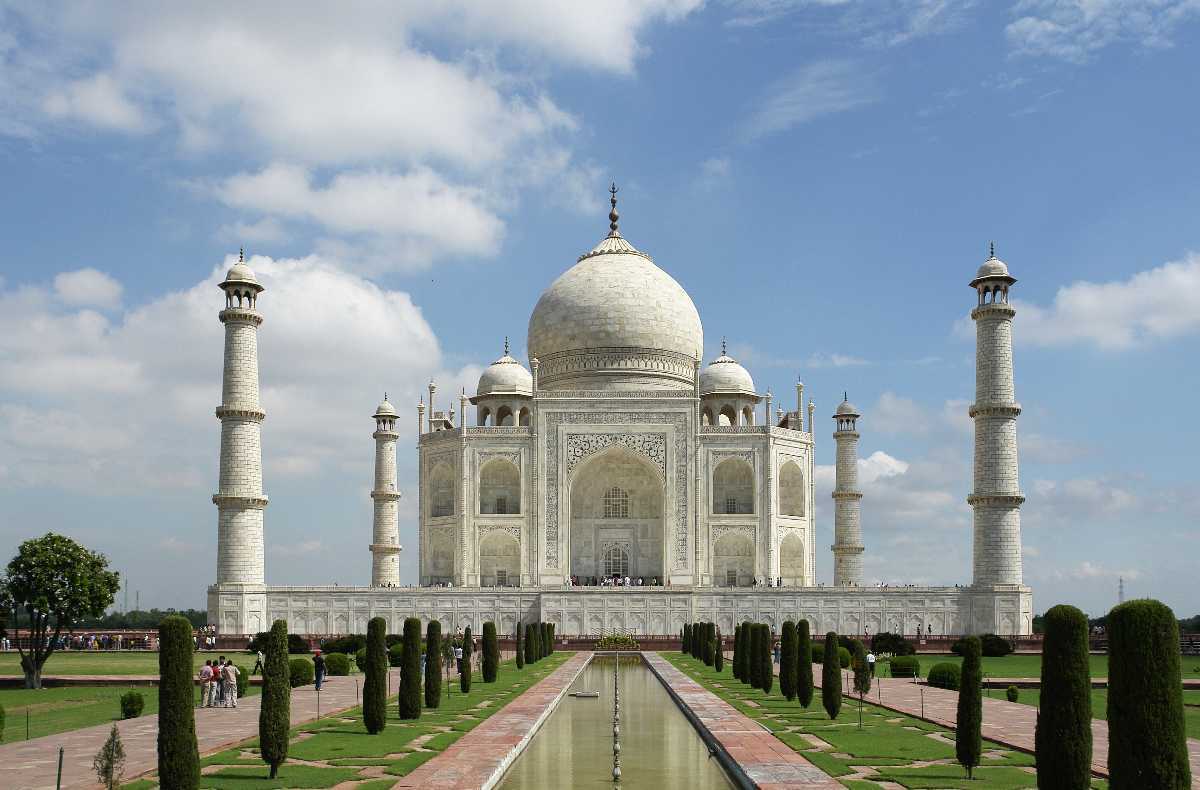Taj Mahal, Agra Overview
What is widely considered as the most beautiful building in the world, Taj Mahal is located in the historical city of Agra. It was built by the Mughal Emperor Shah Jahan as a memorial for his third wife, Mumtaz Mahal. Constructed entirely out of white marble in the 17th century, it is among the finest edifices of Mughal architecture. Recognised by the UNESCO as a world heritage site, this monument is also considered to be one of the seven wonders of the modern world. Every year visitors numbering more than the entire population of Agra pass through the magnificent gates to catch a glimpse of this breathtaking monument, and only a few leave disappointed. Shah Jahan said about the Taj that it made “the sun and the moon shed tears from their eyes“.
The Taj Mahal stands for the Crown of Palaces in the Persian language. It rises from the dust-beaten earth of Uttar Pradesh, but even the wildest imaginations leave visitors underprepared for this world wonder. Covering an area of approximately 42 Acres, the Taj Mahal was constructed using white marble obtained from Makrana in Rajasthan.
Rabindranath Tagore described it as “a teardrop in the cheek of eternity” while Rudyard Kipling said it is “the embodiment of all things pure“. The construction of the Taj Mahal began in 1631 and took 17 years before it was completed in 1648! The tomb is laid out in a rectangular shape and can be approached through a massive gateway which has an arch and alcoves on either side of it. The Taj, so majestic from the exterior, has equally splendid artistic work done in the interiors. There are water channels and fountains in the entrance which makes the monument even more spectacular. The reflection of this majestic spectacle in the Yamuna is almost poetic in its perfection!
Tips For Visiting Taj Mahal
1. Taj Mahal can be accessed through three gates. Tour groups enter through the east and west gates and independent travellers through the south gates. The east gate has the shortest queues. There are separate lines for men and women at all three gates.
2. Cameras and videos are permitted. However, photography is prohibited inside the main mausoleum .
3. Don’t forget to retrieve your free bottle of water (500ml) and shoe covers which are included in the ticket price.
4. You can store your luggage for free beside the ticket offices and also pick up an audio guide for INR 118.
5. Visitors are allowed to use free Wi-Fi internet service inside the compound for half an hour, and then they will be charged at INR 30 per hour after the half hour is complete.
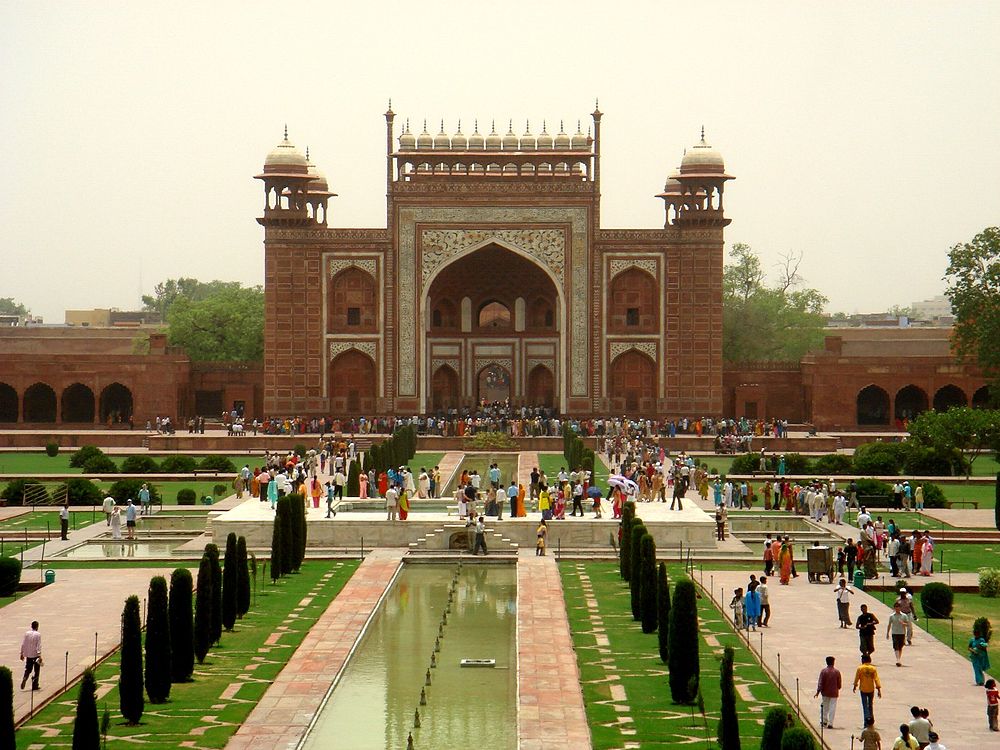
Taj Mahal Night Tour
Viewing the Taj Mahal at night is available on five days on a month, including a full moon night and two nights before and after the full moon. All these aspects, the dates and the timings for the night viewing of the Taj are decided by the Archaeological Survey of India. Viewing the Taj Mahal at night takes place between 8:30 PM to 12:30 PM in 8 batches of about 50 people for about 30 minutes each. Hence, only 400 people are allowed on a single night.
While visiting the Taj Mahal at night, visitors are required to reach half an hour before their scheduled time at the Shilpagram complex. They aren’t allowed inside the monument at night and can view the Taj Mahal only from a bit of a distance. All belongings and luggage have to be deposited at a security counter before the night viewing starts. Video cameras are not allowed inside the monument during the night viewing.
—————————-
Agra Fort, Agra Overview
“An Epitome of the Mughal Dynasty”
An architectural masterpiece, The Red Fort of Agra or Agra Fort was built by Emperor Akbar in 1573. It is, in fact, a massive fortification located on the right bank of the River Yamuna in Agra, Uttar Pradesh and is made entirely of red sandstone. The fort was once the ersthwhile residence of the Mughals until the year 1638. One of the UNESCO World Heritage Sites and lies at a distance of 2.5 kilometres from another wonder of the modern world – The Famous Taj Mahal. The area of Agra Fort is so massive that it is often referred to as a walled city. Made from red sandstone brought to Agra all the way from Rajasthan, this imposing structure is as majestic as it is beautiful and delicate.
Agra Fort is one of the most special monuments built by the Mughals and has richly decorated buildings. It is the perfect example of the Mughal style of art and architecture and is one of the most visited tourist spots in Agra. Built purely out of red sandstone, this expansive architecture stands out against the soft azure of the sky. Within the premises of the fort lie the most exquisite structures of the Mughals like the Pearl Mosque, Diwan-i I Khas, Diwan-i I Aam, Moti Masjid and Jahangiri Mahal. Each and every one of these edifices has remarkable handiwork and ornamentation that make this place a delight for every history and architecture lover. You can also get a splendid view of Taj Mahal from the Agra Fort!
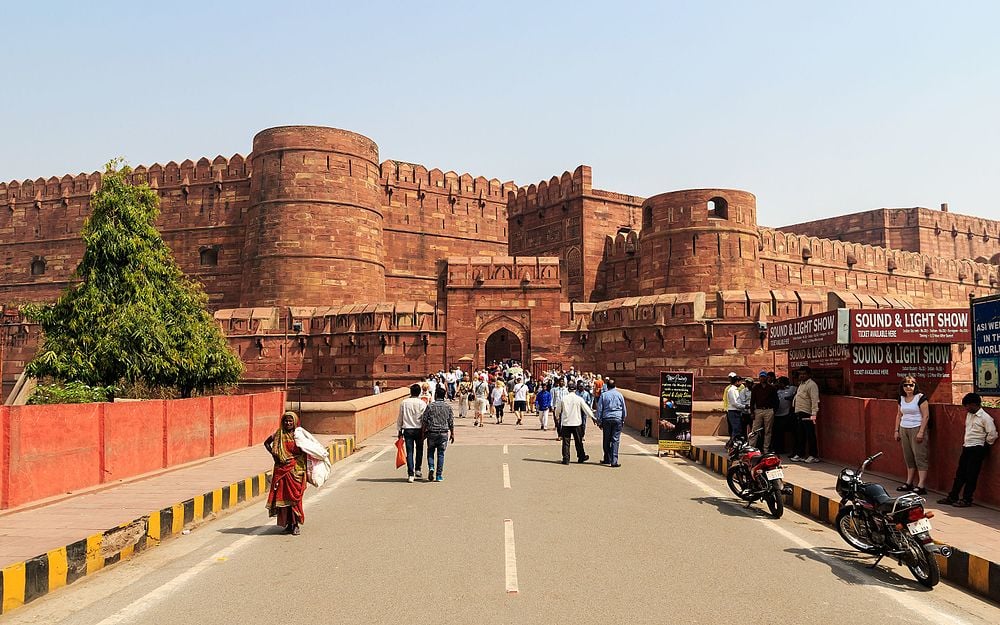
Places to Visit Inside the Agra Fort
1. Jehangir Mahal: One of the first architectures that you will encounter once you enter the Agra Fort through the Amar Singh Gate is the Jehangir Mahal. Jehangir was Akbar’s son and the next in line to rule the Mughal empire after his father. The Jehangir Mahal was built by Akbar as a women’s quarters and was constructed adjacent to the chambers of his favourite queen Jodha Bai. Simple in its design, the Jehangir Mahal is built in stone and has Persian verses carved out beautifully in a large stone bowl used for storing rose water.
2. Khas Mahal: Another important structure in the Agra Fort is the Khas Mahal, which has some classical Persian and Islamic influences with a touch of Hindu motifs in its construction. It was the emperor’s sleeping chambers or ‘Araamgah’. Its unique feature is its beautiful paintings on the marble surface.
3. Musamman Burj: Towards the left of the Khas Mahal lies the Musamman Burj, which was also built by Shah Jahan. Octagonal in shape, this tower has an open pavilion which allowed the cool evening breeze to flow right through it. This was the place where Shah Jahan spent his last days whilst he looked out over to to the tomb of his beloved wife, the Taj Mahal.
4. Sheesh Mahal: One of the most exquisite constructions in the Agra Fort, the Sheesh Mahal is a ‘harem’ or dressing room that employs the most sophisticated water engineering designs. The inside of this construction is beautifully decorated with a mosaic of myriad tiny mirrors, hence giving it its name.
5. Diwan – I- Khaas: To the right of the Sheesh Mahal lies the Diwan – I – Khaas, which was a hall especially for private audiences. It is intricately decorated with marble pillars that are studded with floral patterns of semi – precious stones. Adjacent to this is the Mammam-E-Shahi or the Shah Burj, used as the summer retreat.
6. Diwan – E – Am: This was the hall that was open to the general public. It was here that the very famous Peacock Throne was situated, and the room where the throne once used to be is richly decorated with white marble.
7. Nagina Masjid: This shrine was built by emperor Shah Jahan as a private mosque for the ladies of the court.
8. Moti Masjid: Also known as the Pearl Mosque, it is an extremely beautiful structure situated at Agra Fort. The building of the mosque is closed to visitors as of now. Near the Moti Masjid lies the Mina Masjid, which was the private shrine of Emperor Shah Jahan.
Fatehpur Sikri, Agra Overview
“The Pride of Mughal Empire”
A city, predominantly made of red sandstone, Fatehpur Sikri was founded in 16th century by Mughal Emperor Akbar. It is essentially a fortified city built by the king and had been the capital of his Empire for fifteen years. Now a UNESCO world heritage site and a famous tourist attraction, it is a fine example of Mughal architecture. Fatehpur Sikri is home to Jodha Bai’s palace, Jama Mosque, Buland Darwaza, and a Tomb of Salim Chisti among many other famous monuments, each of which, is an integral part of the Indian heritage.
A unique blend of architectural excellence, as well as religious beliefs – sums up Fatehpur Sikri. This monument was built by Akbar to honour Sheikh Salim Chisti, whose prediction of the birth of a Mughal heir came true while Akbar was visiting the then city of Sikri. In honour of the prophecy, Akbar built this city and Jama Masjid, a stunning mosque which is still in use today. He also undertook the construction of three palaces for each of his favourite wives, one a Hindu, one a Muslim and one a Christian. An Indo-Islamic Masterpiece, Fatehpur Sikri is enclosed by an 11 km long fortification wall which has various gateways.
A paradise for History buffs, this place is a must visit! You can go on a one day trip from Agra to Fatehpur Sikri.
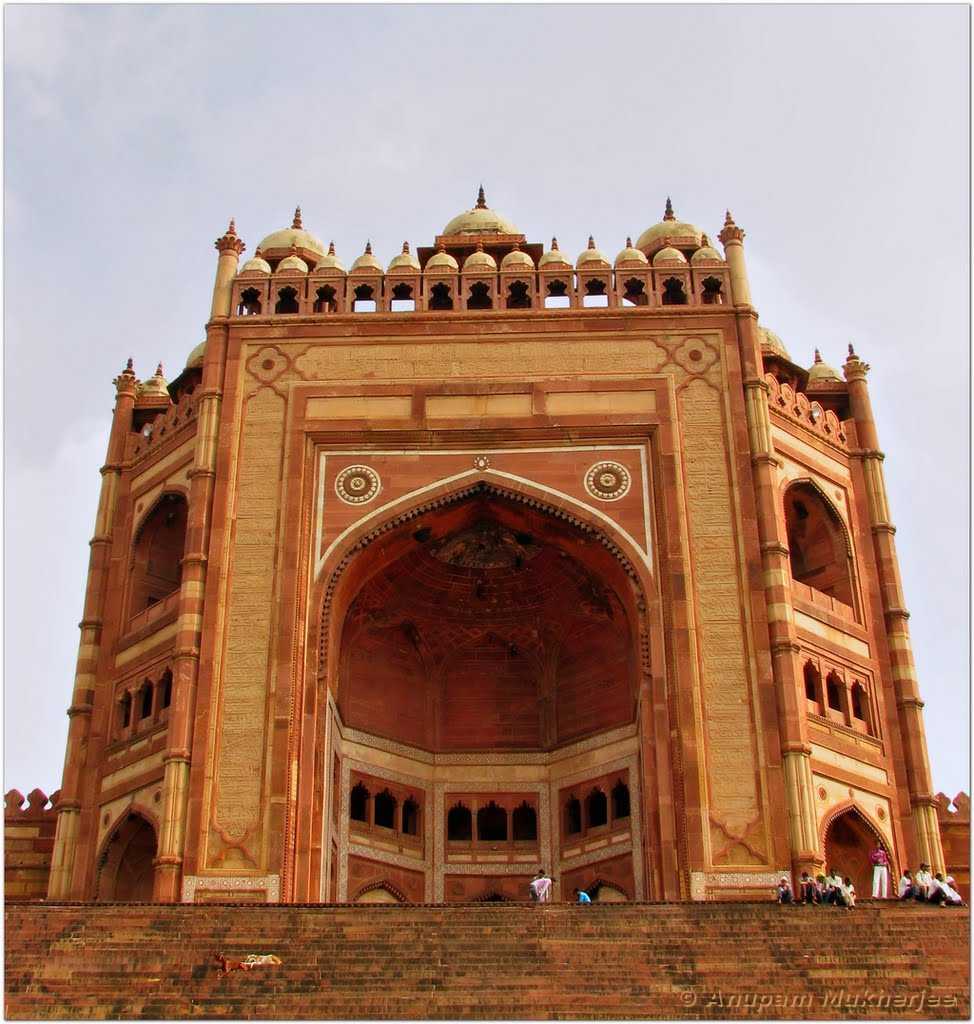
Major Attractions in Fatehpur Sikri
Diwan-i-Aam

As the name suggests, Hall of Public Audience, it was meant to hold public meeting and gatherings. The settlement of public grievances at the hands of the Emperor took place over here. It is a multi-bayed rectangular pavilion-like structure which faces an ample open space. Standing on 49 pillars, the Diwan-i-Aam consists of a Jharokha type chamber which is also known as Takht-i-Murassa. This place has beautiful decorations all over its pillars and walls. Made of Marble is the Bethak where the ministers were to sit. Two gateways and three aisles divide the hall.
Diwan I Khas
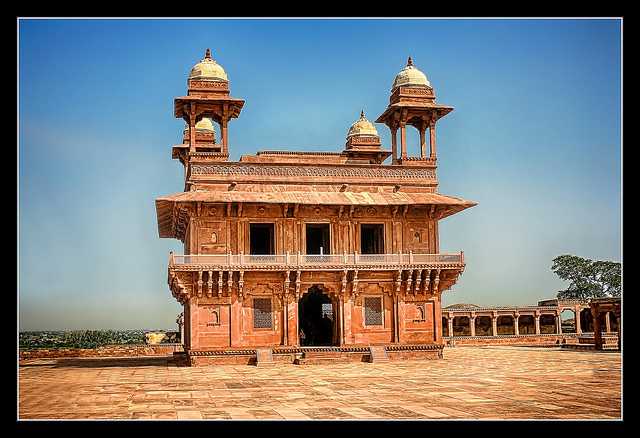
Built in the Persian architectural style, this building was the hall of private audience. Only the royal members assembled here to discuss private affairs. It has a roof with four Chattris. The Central Pillar with a square base and an octagonal shaft has brought fame to the architectural masterpiece. Floral and Geometrical designs increase the beauty of the base and the shaft. Furthermore, it’s thirty-six meandering paths act as a support to Akbar’s platform. These are connected to every corner of the building on the first floor by four stone walkways.
Ibadat Khana
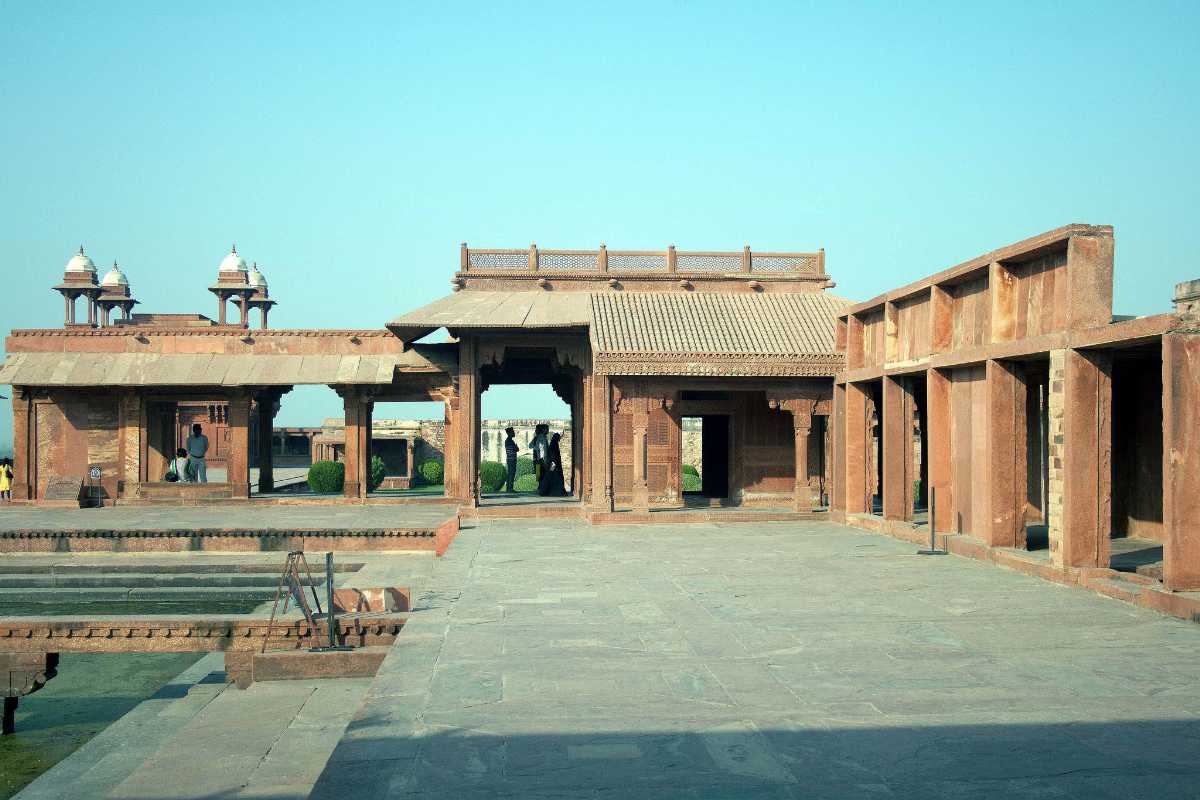
Panch Mahal

An extraordinary structure at Fatehpur Sikri, the Panch Mahal has the design elements of a Buddhist Temple. Entirely columnar, it has four storeys in decreasing size built asymmetrically over the ground floor. The structure contains 176 columns with Jaalis or the screens suggesting the presence of the Purdah System which the Queens had to follow.
The pavilion gives a splendid view of the fort. Panch Mahal has a pool, the Anoop Talab in front of it which once was a setting for musical concerts.
Tomb of Salim Chisti

Enshrining the burial place of the Sufi saint, Salim Chisti, the tomb is the most beautiful example of Mughal Architecture. It finds its place in the courtyard of the mosque. Emperor Akbar took on to the building of this tomb as a mark of respect for Salim Chisti who foretold the birth of Jahangir, Akbar’s successor. The main building of this tomb is enclosed by the marble screens from all the sides. The door of the main chamber is carved beautifully with the patterns and inscriptions from the Quran. The marble made floor has multicoloured stones laid over it. The inner chamber of the tomb consists of the wooden canopy where inlays the mosaic of the mother of pearl. The Tomb is known for its Child Birth Blessings. Devotees from all over the country visit the tomb with hope of fulfilment of their wishes. People tie threads over the marble screens as a reminder of their aspirations to Salim Chisti.
Jama Masjid

It was a congregational mosque that was one of the first buildings erected in the city. Built in the 17th century, Jami Masjid is a World Heritage Site now. Also known as the Friday Mosque, it is the most visited place in Agra. Devotees consider it as a pilgrimage destination.
The Mosque is a transition in Islamic Architecture mixed up with that of Persian Style. The visitors find golden inscriptions on a royal blue coloured background which is a tribute to this fusion. Following this, the interiors are embellished with watercolour paintings giving a glimpse of stylized floral designs. Corbelled pendentives support the dome in comparison to squinches which support the domes usually.
Buland Darwaza
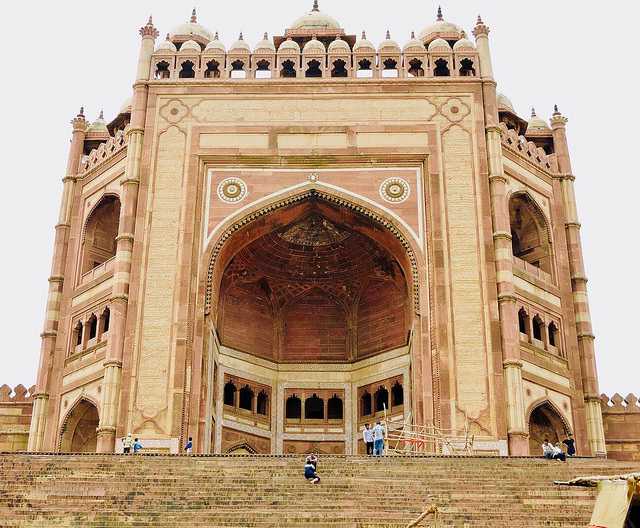
Gate of Magnificence, the Buland Darwaza is a symbol of kbar’s victory over Gujarat. It is the grand doorway that leads to the Fatehpur Sikri from Agra. The grand door is the result of 12 years of continuous hard work. Made up of red sandstone and decorated with white and black marbles it is 50 metres from the ground. The archway has two inscriptions, out of which one reads: “Isa, Son of Mariam, said: The world is a bridge, pass over it, but build no houses on it. He who hopes for an hour may hope for eternity. The world endures but an hour. Spend it in prayer, for the rest is unseen”.
Mariam-uz-Zamani’s Palace
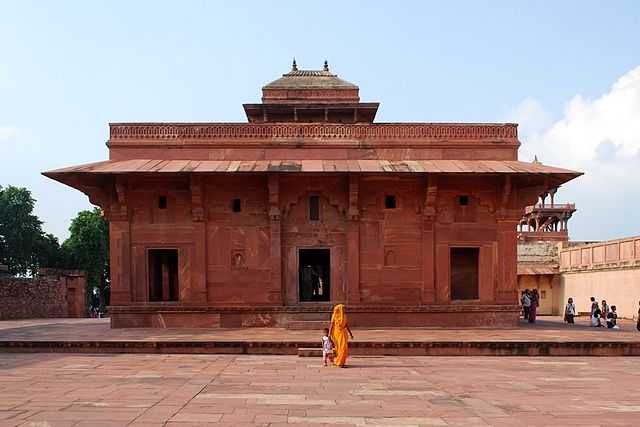
Also known as Harkabai or Jodhabai, Mariam-uz-Zamani was the wife of Emperor Akbar in whose dedication the Palace came into existence. It is an architectural delight for the people visiting the Fatehpur Sikri. The Palace shows a compelling mixture of Rajput and Mughal Architecture. Located on the eastern side of the court, the place was a home to Akbar’s Rajput Queens and the other members of Harem.
Hiran Minar

Octagonal at the base, circular in the middle and tapering at the top, the Hiran Minar has a unique build. Initially thought to be a memorial of Akbar’s favourite elephant it later served as the purpose of Akash Deep during Akbar’s reign. It became a starting point for different mile posts.
Birbal’s House

Akbar’s favourite, Birbal was a Hindu minister in his court. The palace finds its place near the northwest corner of Jodhabai’s Palace. It contains four rooms interconnected with open doorways. Two oblong porches are also there. These have a pyramidical roof with triangular roof. The interiors are full of single bordered designs, Arabesque geometrical designs, and floral designs. The first floor has beautifully decorated Jharokas and Chajjas. The domes have carvings of inverted lotus and Kalash designs. Tile work can also be seen here.
Daftar Khana
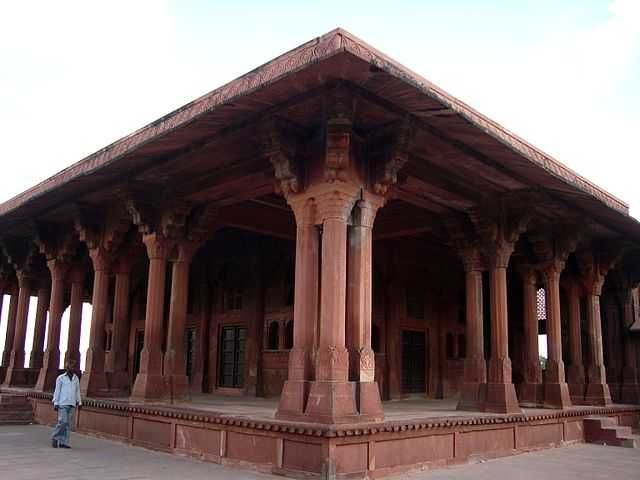
A clone to modern day offices, Daftar Khana was Akbar’s record room. It was a place given to the important files and documents associated with his reign. Built on a high platform, the building has facades on all four sides. There is a room inside which has three doorways on its north and beautifully carved tracery work on red sandstones on its south.
Pachisi Court

Known for his bright ideas, Emperor Akbar brought into existence a unique specimen of grandeur and novelty in the form of Pachisi or the Chaupar Court. Built by Kabar in 1572 AD, Pachisi Court served as a place of amusement for the emperors. They played the game of Pachisi, similar to that of modern-day ludo by some and chess by others. The game instead of being played with original tokens or mohras was played with the person in real. The servants were dressed in the form of symbols and on the emperor demands had to make moves.
This seemed to be a game, but according to Akbar, this was his way of checking his people’s benevolence.
Khwabgah
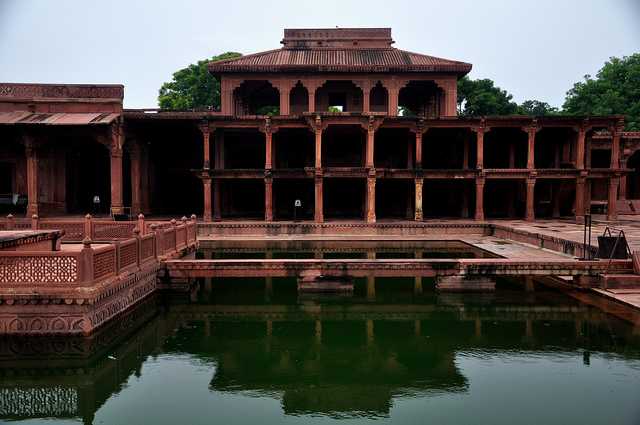
One of the most beautiful complexes in Fatehpur Sikri, it acted as the Emperor’s personal place. It has room for the Emperor to hold separate meetings, a Kutub Khana (own library), a small bathroom, and a bed room for the Emperor. The bedroom had covered connections with the Panch Mahal and the Imperial Haram. Where the ground floor is quite simple, the first floor, the king’s personal space is pompously decorated with geometrical and floral carvings. The mural paintings on the wall depict the court scenes along with the Persian inscriptions which are now faded.
Lower Haramsara

Beside Jodha Bai’s palace and opposite to Birbal’s Palace lies the Lower Haramsara. The reason behind its construction is ambiguous as for some historians it was a stable and for others was a place of servants. The entire structure consists of floral paintings both inside out. The columns here are a mix of Indian and Islamic designs.
Naubat Khana
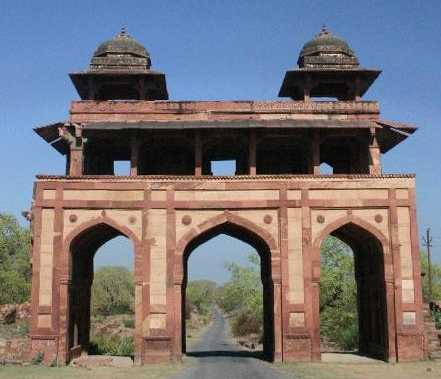
Also known as the Naqqar Khana, the musicians over here announced the coming of the Emperor by beating the drums. The vision, planning and finally the outcome of Emperor’s imagination is something worthy of a courteous tribute. Rich carvings on the sandstone walls spark the extravagance of the genius work of art.













